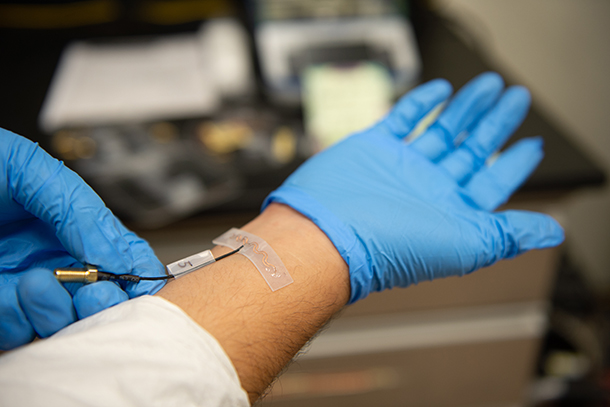
A stretchable wideband dipole antenna, like the one pictured, can improve the performance of wearable technology by changing its physical shape to adapt to body movements and pressure, according to Penn State researchers. Credit: Kelby Hochreither/Penn State
Stretchable, 3D antenna improves wearable tech performance
4/22/2022
By Mariah Chuprinski
UNIVERSITY PARK, Pa. — A new stretchable wideband dipole antenna can improve the performance of wearable technology by changing its physical shape to adapt to body movements and pressure, according to Huanyu “Larry” Cheng, Dorothy Quiggle Career Development Assistant Professor of Engineering Science and Mechanics in the Penn State College of Engineering. The 3D antenna, a component for wearable sensors, is detailed in ACS Applied Materials.
Building on its 2D precursor, the antenna uses mechanical assembly to “pop up” from a flat organization to a 3D structure. It reverses as the wearer stretches.
“The antenna can be stretched in an ordered manner,” Cheng said. “The 3D structure is first transformed into the 2D structure upon the initial stretching and then the 2D serpentine is stretched nearly straight upon further stretching.”
The antenna is also dipole, meaning it has two pairs of radiation arms. By coupling frequencies between the arms, the researchers achieved a large bandwidth in which the antenna can wirelessly receive power and transmit information. According to Cheng, the device performs well even when stretched over 25%.
“The 3D dipole antenna can simultaneously improve the stretchability, enhance on-body performance and automatically adjust to radio frequency changes,” Cheng said. "Compared with its 2D counterpart, the 3D antenna with significantly reduced performance degradation can provide much improved on-body wireless communication and energy harvesting efficiency to enable a self-powered sensing platform.”
In addition to Cheng, the paper was co-authored by Jia Zhu, who earned a doctoral degree in engineering science and mechanics from Penn State in 2020; Zhihui Hu, former visiting professor in engineering science and mechanics at Penn State and current associate professor at Wuhan University of Technology in China; Chenghao Xing, Senhao Zhang, Xianzhe Zhang and Huaiqian Guo, Penn State graduate students in engineering science and mechanics; Chaoyun Song, assistant professor in the School of Engineering and Physical Sciences at Heriot-Watt University in Scotland; Honglei Zhou, researcher in the Institute of Flexible Electronics Technology at Tsinghua University, China; Donghai Qiud, researcher at the Suzhou Institute of Biomedical Engineering and Technology at the Chinese Academy of Science; and Hongbo Yang, researcher at the University of Science and Technology of China.
The National Science Foundation, the National Institutes of Health’s National Heart, Lung, and Blood Institute of the National Institutes of Health and National Institute of Biomedical Imaging and Bioengineering, the International Partnership Program of the Chinese Academy of Science, the Key R & D plan of JiangSu Province and the National Key Research and Development Program of China supported this work.



